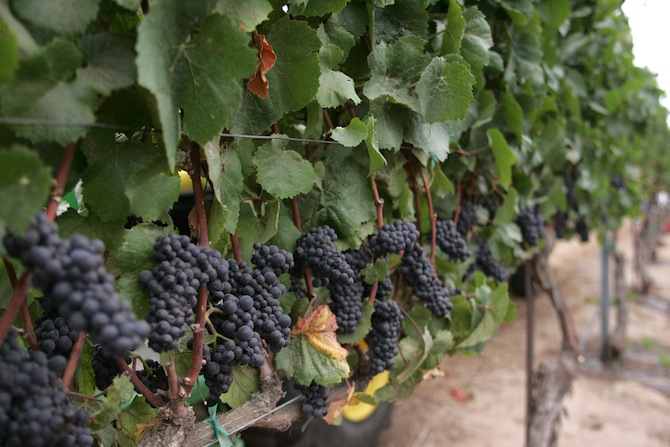
“Did you know that every state in the US makes wine?”
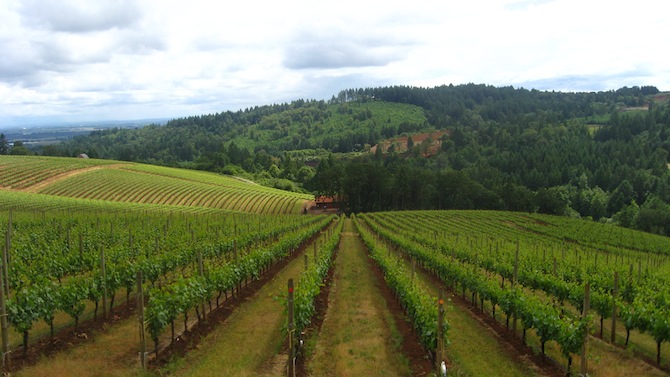
Willamette Valley. Photo courtesy of eyeliam.
Oregon
Let’s start with Oregon, whose wine industry dates back to the early 1880s — although it was in 1961 that their modern wine industry really began. According to Mr. Drouet it was at this time that Richard Sommer took interest in the Umpqua Valley’s cool climate and planted riesling. Today, Oregon and its 16 American Viticulture Areas are renowned for their fine small production wines.
Oregon focuses mainly on pinot noir and pinot gris. Interestingly, out of all 50 states Oregon is the strictest in terms of varietal labeling, as they. with the exception of cabernet, require the wine to be made with 90% of said varietal. In the USA the requirement for all states is 75%, with states having the option to make the rule more strict — but not less — at their discretion.
As I’ve just returned from a trip to the sustainably-focused city of Portland, I’m not surprised to learn that Oregon vintners focus on community, sharing tips and working together for the greater good of selling Oregon wine as a whole, instead of competing in an individualistic manner. I’m also not shocked to hear the state is a pioneer in the sustainable wine making industry.
In terms of style, wine from Oregon is typically higher in acidity and less overtly fruity than most New World wines like California, but less earthy and mineral than Burgundy. If one had to pick a sibling region, New Zealand’s Otago would be it.
In the state the Willamette Valley is by far the largest American Viticultural Area (AVA), home to about 40 wineries and even more wine shops and wine bars. Here you’ll also find a number of sub-districts that are geographically and topographically distinct. Before 2004 there was no differentiation; however, around this time Oregon began creating sub-appellations, which you’ll see listed on the wine bottle. Of these, some of the most important include Dundee Hills, where the earliest pinot noir plantings are; Ribbon Ridge, which is small but high-quality and located in the heart of the Willamette Valley; and McMinnville, the Valley’s most westerly sub-region and an important area for complex pinot noirs.
Outside of the Willamette Valley there’s also the Umpqua Valley, home to Oregon’s first winery, Hillcrest Vineyard, opened in 1962. Moreover, there’s the Rogue River Valley, which, due to its warmer climate, tends to produce fuller-bodied reds like cabernet sauvignon and merlot over pinot noir.
Interestingly, there are a few AVAs that Oregon shares with Washington, including Walla Walla, Columbia Valley and Columbia Gorge. Compared to the other Oregon wine areas producing pinot noirs, pinot gris, riesling, and even chardonnay (mainly Dijon clones), you’ll find Washington varietals like riesling, cabernet, merlot and Bordeaux blends.
Let’s take a look at Oregon through three different wines. The first is a 2011 Argyle Chardonnay from the Willamette Valley ($20). The white wine has notes of tropical fruits and pineapple on the nose — typical of Oregon chardonnays — with cream and butter on the palate. While fruity, the wine has an acidity to match for a nicely balanced wine.
The 2013 Ponzi Pinot Gris ($19) is from one of the Willamette Valley’s most esteemed producers. The wine is one of the best I’ve tasted since Day 1 of the sommelier certification course. It’s completely different from the previous chardonnay, with notes of stone fruit and a lower acidity. It’s fruity but dry, and has a great balance, especially for a fruit-forward style of wine.
Then, there’s one of Oregon’s reds with a 2011 Andre Rich “Prelude” Pinot Noir from the Willamette Valley ($25). The red wine is light in color as thin-skinned pinot noirs are, with somewhat smokey aromas.
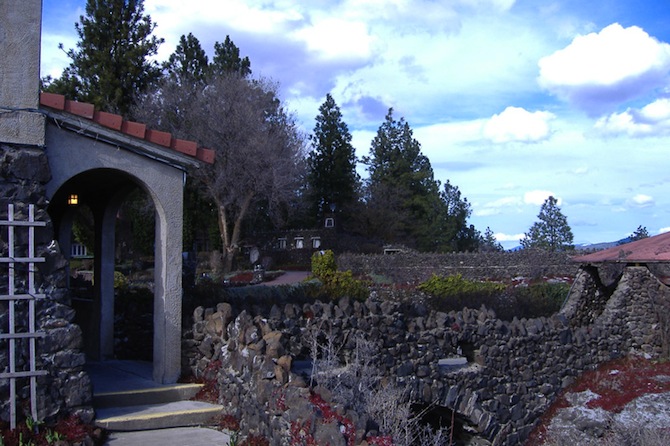
Arbor Crest Wine Cellars in Washington. Photo courtesy of James Hawley.
Washington
I am surprised to learn Washington, which is the country’s third-largest wine producing state, is the benchmark for Merlot, although I’ll admit I’m not very familiar with the state’s wines.
Along with Bordeaux blends, another wine Washington is starting to produce really well-made riesling, some dry but typically kabinett level sweetness (if we were to compare to German wines).
In Washington there are 11 AVAs, all but one of which is east of the Cascade Mountain Range. This is because of rain, as the Puget Sound, while beautiful, tends to be cold and wet — not conducive to growing quality red grapes.
Of these 11 AVAs, Columbia Valley is by far the largest, featuring more than 11,000,000 acres (4,500,000 hectares). Of this, over 40,000 acres (16,000 hectares) is vineyards. To put this into perspective, 99% of Washington’s wines come from this valley. While you’ll find a large number of micro-climates, the majority of the region is affected by warm days and cool nights, leading to wines with higher acidity and more mature tannins. You’ll often find Columbia Valley wines to showcase a mix of New World and Old World characteristics, fruit-forward wines with balance and structure.
For a taste of Washington we first sample an off-dry 2013 Kung Fu Girl Riesling ($8) which offers a fun label featuring chopsticks that tells you something about the wine (hint: it pairs well with spicy and Asian foods). On the nose there are lots of floral fragrances and stone fruits, while a sip shows high acidity, bringing the perceived sweetness down. One way to see if a wine is actually sweet is to take a sip, wait 10 seconds, and see if you still perceive sweetness on the palate once the fruit flavors have settled down.
There’s the Pitch Cabernet Sauvignon from the Columbia Valley, with notes of black fruits, medium acidity and some herbaciousness on the palate. The lack of minerality reminds us it’s a New World Wine, and the finish isn’t short but it’s also not long. It’s a quaffable wine that’s “squeaky clean” — which means it’s has no rough ends — and is good albeit somewhat uninteresting.
Also yummy is the 2011 Powers Merlot, which shows us the other side of the coin. Compared to the cabernets blackberry and black currant aromas, the nose on the merlot is a little shy. On the palate, there is higher acidity, more tannins (that are also somewhat rough) and a longer finish.
These two last wines show us how it’s important to know what your needs are when it comes to wine. For example, the cabernet is easy drinking and doesn’t require food, making it ideal for a small ambient bar focused on drinks; however, the merlot has bigger tannins and isn’t quite as polished, and would be better appreciated paired with a meal.
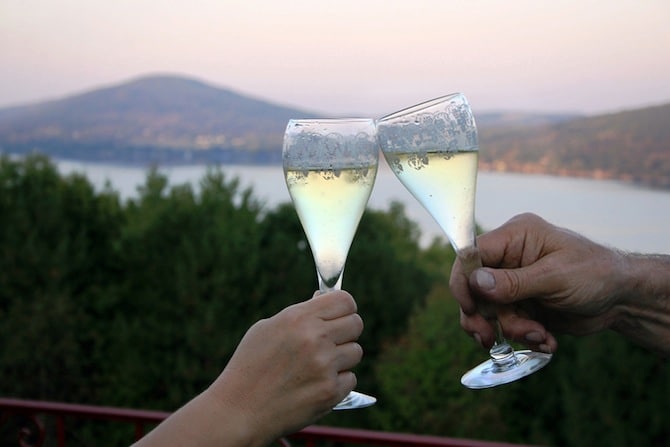
Wine with a view in the Finger Lakes. Photo courtesy of Visit Finger Lakes.
New York
In between California and Washington is New York, the country’s second-largest wine-producing state. There are four main regions here: the Finger Lakes, the Hudson River Region, the Lake Erie District and Long Island. Of these, the two we discuss most in class are the Finger Lakes and Long Island.
This area is known for planting hybrid grapes, a cross of two different species, typically a vinifera and a non-vinifera varietal. But why would anyone do this when not many people recognize hybrid grape names? Along with being better able to defend themselves against phylloxera, the grapes made for the Finger Lakes can also thrive in very cold climates, allowing this region to create fine wines from vines that survive the cold winters and grapes that ripen as they would in a warmer climate. Some top Finger Lakes hybrids include seyval blanc, ravat, baco noir and chancellor.
Long Island, on the other hand, grows 100% vinifera. Here you’ll find the warmest, sunniest wine region in the northeast, with most wineries located on the North Fork. They focus on Bordeaux varietals like merlot, cabernet sauvignon and cabernet franc, as well as whites like chardonnay, sauvignon blanc and riesling — although that’s hardly all they plant. Thanks to the island’s proximity to the sea, temperatures are moderate. This maritime climate combined with glacial soils and long summers allow for a large array of grapes to be planted — including surprising varietals like Carmenere, Chile’s signature grape, and Blaufränkisch, well known in Austria’s wine region.
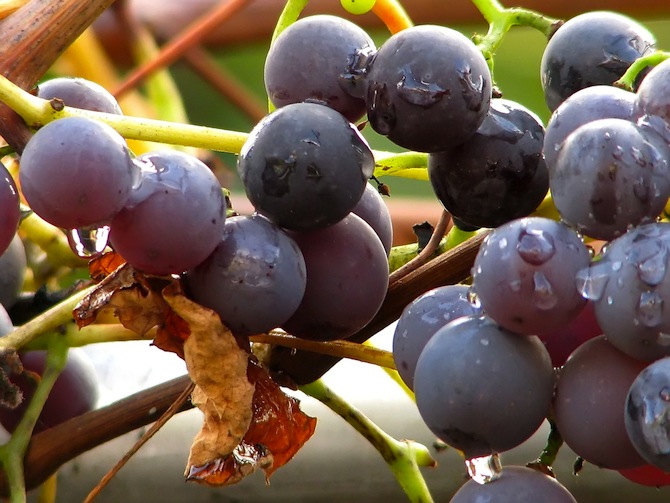
Wine grapes. Photo courtesy of Noel Zia Lee.
It’s interesting to note how New York State has changed its philosophy in recent years. For anyone who has visited the state recently, you may have noticed a sudden popping up of wineries, breweries and distilleries. This is because the state is trying to promote New York products, and have relaxed the licensing requirements.
I savored a taste of New York through three different wines. The first is a 2013 Thirsty Owl Riesling ($11) from the Finger Lakes, a dry, fruit-forward wine with a pronounced acidity and aromas of lime, pear and apricot — classic characteristics of riesling. This is a great example of home a wine can be fruity yet unsweet. If a wine is sweet, you’ll detect it on the tip of your tongue. You may also want to try closing your nose so that the aromas don’t misguide you to thinking the wine is sweet.
Then there’s the 2012 Bedell Cellars Cabernet Franc ($22). With this wine you’ll find vegetative and green aromas, although I’m surprised on the palate how fruity it is. While I enjoy the wine, it’s definitely not a classic example of the typically more savory cabernet franc.
Fabulous is the 2012 Estate Reserve Chardonnay barrel-aged in 100% new French oak from One Woman Winery ($48). The wine smells of tropical fruits, mainly pineapple, and is full-bodied and bright, although the oakiness says the wine could use a bit more aging time.
Top Photo courtesy of Hahn Family Wines

Jessica Festa is the editor of the travel sites Jessie on a Journey (http://jessieonajourney.com) and Epicure & Culture (http://epicureandculture.com). Along with blogging at We Blog The World, her byline has appeared in publications like Huffington Post, Gadling, Fodor’s, Travel + Escape, Matador, Viator, The Culture-Ist and many others. After getting her BA/MA in Communication from the State University of New York at Albany, she realized she wasn’t really to stop backpacking and made travel her full time job. Some of her most memorable experiences include studying abroad in Sydney, teaching English in Thailand, doing orphanage work in Ghana, hiking her way through South America and traveling solo through Europe. She has a passion for backpacking, adventure, hiking, wine and getting off the beaten path.








